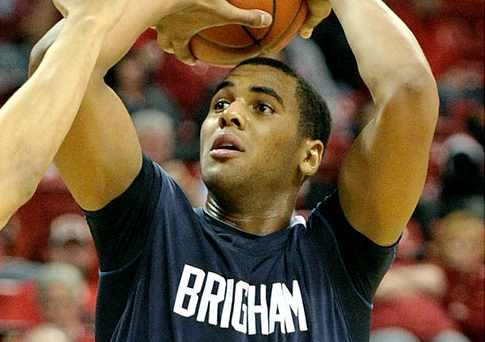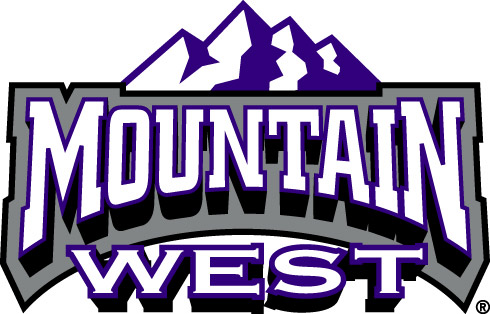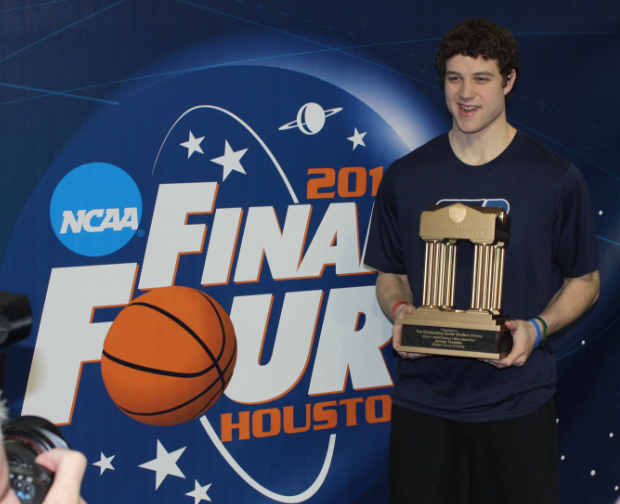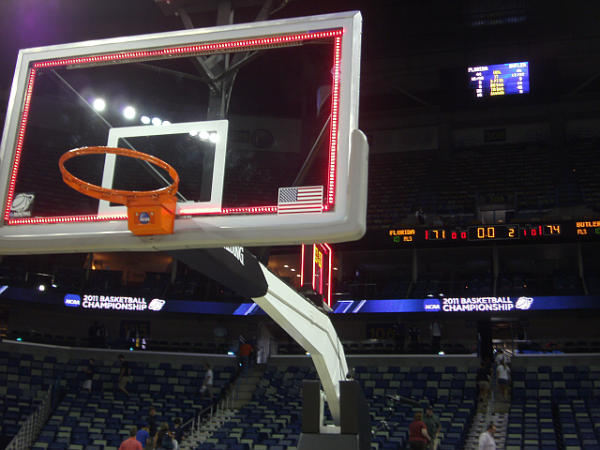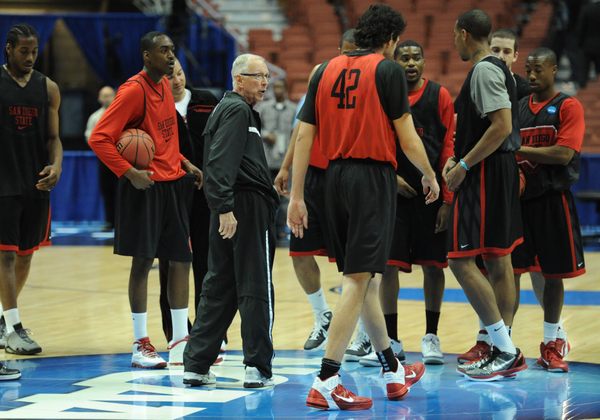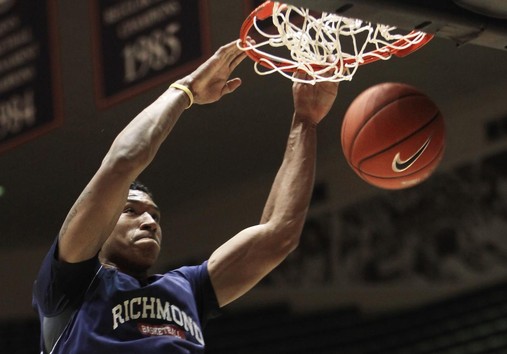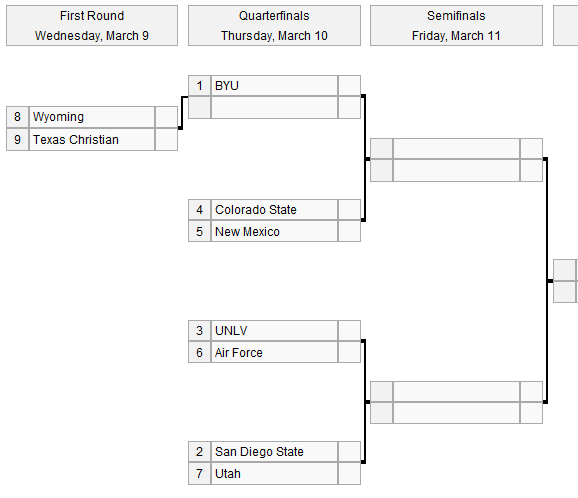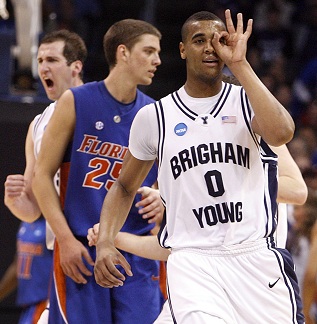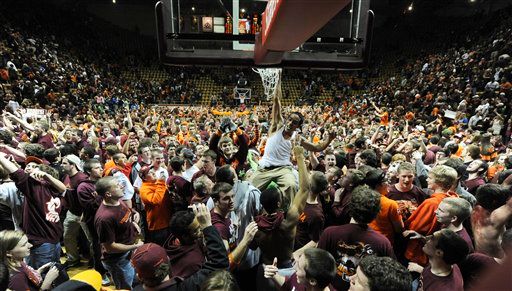
Andrew Murawa is the RTC correspondent for the Mountain West and Pac-10 Conferences.
[Ed. Note: This was published before BYU suspended Brandon Davies for the rest of the season.]
A Look Back
With BYU’s second 13-point win of the season over San Diego State on Saturday, the Cougars have put the clamps on their first outright regular season Mountain West Championship since 2007-08. They’ve got a one-game lead now over the Aztecs, but own the tiebreaker as a result of their two head-to-head wins, so one more win clinches the #1 seed in the MWC Tournament and two more wins (in their two remaining games) sews up the conference title all for themselves. We’ll have more on the game below, but elsewhere around the conference, it is looking more and more like a three-bid league. While SDSU and UNLV can count on their Selection Sunday invitations arriving without delay, Colorado State’s hopes for its own at-large invitation to the NCAA Tournament took a huge hit on Saturday when they got run out of Clune Arena by Air Force, failing to score for almost nine minutes in the second half and dropping their tenth game of the season. Barring a big late run by the Rams, which would have to include a win at San Diego State on the final Saturday of the regular season, or a surprising run by somebody else outside of the top three seeds in the MWC Tournament, the Cougars, Aztecs and Rebels will be the entirety of the MWC representatives in the Big Dance.
- Team of the Week: BYU – In their final season as members of the MWC, the Cougars have fought through numerous hurdles on their way to all but clinching the regular season title. They’ve been able to deal with the distractions of the media circus surrounding the traveling Jimmer Fredette show (although, in all honesty, the benefits of having a guy like Fredette obviously outweigh whatever distractions his presence may bring), they’ve weathered the taunts and jeers of jilted and jealous fans across the conference, and they’ve replaced players lost due to injury or calling. And when all is said and done, they’ve put themselves in position to be in strong consideration for a #1 seed in the NCAA Tournament. They’re the #1 team in the RPI, they’ve got a 27-2 record on the season, an 8-1 record against top-50 RPI teams, and, if they can take care of business in the regular season, then continue their success into the MWC Tournament, they’ve almost got to get a #1. Of course, winning the MWC Tournament is a whole other consideration, as BYU is just 6-4 in the MWC tourney since it returned to Las Vegas in 2007, with three losses to UNLV (and one to SDSU) mixed in there. While this Cougar team has made a habit of proving that it is different from previous incarnations, the prospect of either beating UNLV on its home court for the second time this season or beating SDSU for the third time this season is one challenge I’m very interested in seeing the Cougars face.
- Player of the Week: Dairese Gary, Senior, New Mexico – Gary has been the one constant for Steve Alford this year, but this past week he took his game to another level. In a tough home loss against UNLV, Gary put up 26 points on 10-15 shooting, six assists, three steals and a couple of threes. After finding that such a contribution just wasn’t enough, Gary made sure to get the job done at TCU over the weekend, scoring 32 points on 11-14 shooting, with nine assists, another steal and three more threes. While this has not been the type of season that Lobo fans expected, their senior leader has more than lived up to expectations and he’ll be sorely missed in Albuquerque next year.
- Newcomer of the Week: Quintrell Thomas, Sophomore, UNLV – The Kansas transfer has come on in a big way down the stretch for the Running Rebels, and when he gets minutes, he produces for Lon Kruger. Since the start of February, Thomas has gotten more than 20 minutes four times, including twice in the last week. In those four games, he has averaged 15.8 PPG and 11.5 RPG, and over four offensive rebounds in those games. This past week he posted 34 points and 20 rebounds, made 12 of his 19 shots from the field and got to the line 14 times and converted ten times. While the Rebels still have major question marks from behind the three-point lines, Thomas has helped clear up any questions about their ability in the paint.
- Game of the Week: BYU 80, San Diego State 67 – It was, almost without a doubt, the biggest basketball game in the history of the Mountain West Conference. It may not have had a dramatic finish, but it’s the only choice as the MWC game of the week. Fredette continued his sterling season by matching his season high of nine assists, turning into the distributor rather than the scoring point guard that had taken the college basketball world by storm (and the fact that a 25-point, four three-point game is proof of Fredette backing away from his score-first persona tells you exactly how great of a scorer he is). With Steve Fisher giving Fredette several different looks defensively, from the long defenders like Billy White and Kawhi Leonard to the more traditional defender in Chase Tapley, to double-teams of all sorts, Jimmer had plenty of chances to set up his teammates for clean looks from deep, and they responded beautifully, as the Cougars knocked down 14 of their 24 shots from deep. That, coupled with the Aztecs repeatedly missing point-blank shots following offensive rebounds, explains the final score, but while BYU did everything right to earn their victory, most college basketball fans without a rooting interest in the outcome would love to see these two teams run this one back in a week and a half.
- Game of the Upcoming Week: Colorado State (18-10, 8-6) at San Diego State (27-2, 12-2), 3/5, 7pm, The Mtn. – If the Rams are going to continue to entertain any notions about a possible at-large bid to the NCAA Tournament, this is an absolute must-win. A loss here, and their only chance at a bid is running the gauntlet through Utah or New Mexico in the first round of the MWC Tournament, BYU in the semifinals and either San Diego State or UNLV in the finals. In other words, win this game. And, really, even if they win this game, they are still completely bubblicious, and would really need a semifinal victory over BYU in order to ease their worried minds a bit, but first things first: win this game. And in order for that to happen, there are a few events that need to take place. First, Andy Ogide needs to continue his strong play, and given that he has only failed to score in double figures once on the season, has only shot less than 50% from the field four times this year and has posted nine double doubles, that is a likelihood provided he can stay out of foul trouble against SDSU’s talented front line. More troubling for Tim Miles is finding somebody else on his team that can help Ogide out. Travis Franklin is the team’s second leading scorer, but he’s scored exactly 11 points over the span of the team’s three-game slide and hasn’t posted back-to-back games in double figures since January. Adam Nigon, Wes Eikmeier, Dorian Green, and Greg Smith (among others) have all shown the ability to be that big second-option to Ogide, but none have proven their ability to be consistent. For all the improvement that the CSU basketball program has made in Miles’ four years on campus, now is their time to finish the deal and get back to the NCAA Tournament.
Power Rankings
1. BYU (27-2, 13-1): We’ve talked about Fredette and Jackson Emery in this space quite often. We’ve talked about the emergence of Brandon Davies (though the Cougars now have to survive without him after an honor code violation led to his suspension for the rest of the season). We probably haven’t talked about Noah Hartsock and Stephen Rogers and Charles Abouo enough, but suffice it to say, each of those guys has made significant contributions on the Cougars’ way to that gaudy record above. The guy we haven’t talked about near enough is the guy at the end of the bench, head coach Dave Rose. Rose has been nothing short of spectacular in his time in Provo. He took over a program that had just finished last in the conference with an abysmal 9-21 campaign, and since then he has never once finished lower than second place in the conference. Assuming the Cougs finish the deal this year, he will have three outright MWC titles in six years, another shared title and a couple second place finishes. All that’s impressive enough, before you even mention his biggest win of all, surviving a bout with pancreatic cancer a couple of years back. On the verge of his third MWC Coach of the Year award and more than a couple of National Coach of the Year votes, Rose is every bit as important to the success of this BYU program as is the scoring machine from Glens Falls.
A look ahead: The Cougars get a chance to avenge their only MWC loss when they host New Mexico on Wednesday with a chance to wrap up the #1 seed in the conference tourney. On Saturday, they’ll complete the regular season by hosting Wyoming.
2. San Diego State (27-2, 12-2): In his two games this year against BYU, D.J. Gay has scored eight points, handed out seven assists and grabbed four rebounds. He’s made just two of his 14 shots from the field, has been largely invisible on the defensive end and simply has shown no signs of being the positive on-court leader that he has proven himself to be in the rest of his games this year. While what blame there is for the losses to BYU does not fall solely on Gay’s shoulders, he’ll need to play more like the type of guy who won duels with Casper Ware, Anthony Marshall and Dairese Gary earlier in the season in order for the Aztecs to live up to their March dreams.
A look ahead: The Aztecs finish up with a trip to Wyoming tonight, then senior night at Viejas Arena during which The Show will say goodbye to Gay, Billy White, and Malcolm Thomas. And, they might as well say goodbye to Kawhi Leonard while they’re at it.
3. UNLV (22-7, 10-5): The Rebels have now won eight of their last ten games (losses at BYU and home against SDSU) since Tre’Von Willis returned from missing a couple of games with a knee injury. Willis has now scored in double figures in six of the last seven games and has averaged over 16 points a game over that stretch, just a notch below the 17.2 he averaged all of last season. He’s also averaged four assists per game in those seven games, and the box scores will tell you that Willis is back. Then you watch a game. And you see Willis dragging that left knee up and down the court. Every now and then he surprises you and blows by a defender with an explosiveness that reminds you of what he was like at the top of his game last year, but for the most part, it is pretty clear that Willis is really just squeezing every last drop of goodness out of a knee that needs at the very least some rest and more likely needs some medical attention. Can the Rebels win a game or two in the NCAA Tournament with a gimpy Willis? It remains to be seen, but you can never count out a tough old veteran like him.
A look ahead: The Rebels travel to Utah on Saturday to wrap up their season before hosting the MWC Tournament at the Thomas & Mack as a #3 seed.
4. Colorado State (18-10, 8-6): This Ram team already had a couple bad losses on their scorecard: a home loss to Sam Houston State and a neutral-site loss to Hampton. This team had also lost more than one game in a stretch this season, when they lost back-to-back games at Colorado and Kansas. And yet, with all that, they were still solidly on the bubble. Then came this weekend’s loss at Air Force, their third loss in a row, during which only Ogide was even remotely effective. The rest of the CSU starting lineup went a combined 5-30 from the field. Really. 16.6%. On the final weekend of February. Coming off losses to BYU and UNLV. With an NCAA Tournament bid on the line. For the Rams to get back to the NCAA Tournament for the first time since 2003, they now have to do something that they’ve given little reason to believe they are capable of doing: beat both San Diego State and BYU in their next four games, while at the same time taking care of their other business. They did play SDSU to the buzzer a month ago, but that was at home. To go to Montezuma Mesa and beat the Aztecs on Senior Day? That’s quite a challenge.
A look ahead: Before that SDSU game, the Rams have to get back on track at home against a rested and hot Utah team.
5. New Mexico (18-11, 6-8): The Lobos broke their four-game losing streak behind Gary’s heroics, but of bigger concern for Alford is the inability of any other Lobo to provide consistent offensive production. While the Lobos are still in the top 50 in offensive efficiency, their shooting percentages are headed downward and the confidence of guys like Philip McDonald and Kendall Williams is plummeting, with each guy thinking too much about his shot and often passing on good looks. While the Lobos are still talented enough to make things tough for a higher seed in the MWC tourney, they’re not playing anywhere near their best basketball right now.
A look ahead: The Lobos have already beaten BYU once this season, but this time around, given the visit to the Marriott Center looming, the challenge is a bit tougher. On Saturday, they’ll close out the regular season by hosting Air Force.
6. Utah (13-15, 6-8): The Utes haven’t played since we last checked in, so not much new to report on them, but it is interesting to note that the only games the Utes have won in conference are against Wyoming, New Mexico and TCU, and they’ve swept all three teams.
A look ahead: With Colorado State and UNLV looming on the Utes schedule, unless they pull off an upset, they’ll wind up being swept by the other five teams in the conference.
7. Air Force (14-13, 5-9): The Falcons broke their four game slide with the big win against CSU, and did so in convincing fashion. They effectively shot 61% from the floor and held the Rams to just a 36.4 effective field goal percentage, and even beat the Rams from the free throw line, outscoring them 24-14, a rather uncommon occurrence for the Academy. Sophomore guard Michael Lyons continued his strong breakout season, scoring in double figures for the fifth straight time and for the 18th time on the season, while the versatile senior Evan Washington, who has taken a backseat in the scoring department this season, continued to contribute in other ways, handing out eight assists and grabbing four rebounds. Washington has in many ways been the consummate Academy player, doing whatever is needed of him to help the team. Last year as the Falcons struggled through injuries to an eighth place finish, Washington was called on to score more, and he provided over ten points per game. But this year he has been asked to be more of a distributor and has racked up nearly a 2-1 assist-to-turnover ratio this year
A look ahead: The home crowd says goodbye to Washington on Wednesday as the Falcons host TCU, then they travel to New Mexico on Saturday to wrap up the regular season.
8. Wyoming (10-18, 3-11): Fred Langley continues to get great production out of sophomore forward Amath M’Baye, who added 24 points and seven rebounds in a loss at UNLV. He has averaged 21 points per game since the dismissal of Heath Schroyer and is now averaging 12.3 points per game.
A look ahead: Wyoming hosts SDSU then travels to BYU in a nightmare end to a nightmare season.
9. TCU (10-20, 1-14): Speaking of nightmares, the Horned Frogs have now lost 16 of their last 17 games. And in doing so, they’ve been bad everywhere. They don’t shoot particularly well, and they certainly can’t keep opponents from shooting well against them. They get killed on the glass as if it were their collective life’s meaning. They never get to the line, but they send their opponents to the line regularly. They’re a very bad basketball team. And yet, somehow, junior J.R. Cadot is ranked #41 in the nation in Ken Pomeroy’s offensive rating. Typically, despite an offensive rating higher than guys like Jon Leuer, Nolan Smith, Kemba Walker and Jimmer Fredette, Cadot only uses about 15% of all TCU possessions when he is in the game. Sure, if he was used at a higher rate, his efficiency numbers would likely drop, but given that Garlon Green is the only other Frog with an offensive rating above 100, you’d figure that Jim Christian would find a way to use him more. Cadot’s numbers had been picking up, as he averaged over 14 points a game in the four games before his one-point, two-field-goal-attempt stinker against in the loss against New Mexico, but given that there’s not a whole lot else going on in Fort Worth, you would hope that Cadot would get a chance in TCU’s remaining games.
A look ahead: Mercifully, the Frogs wrap up their regular season at Air Force on Wednesday.





























